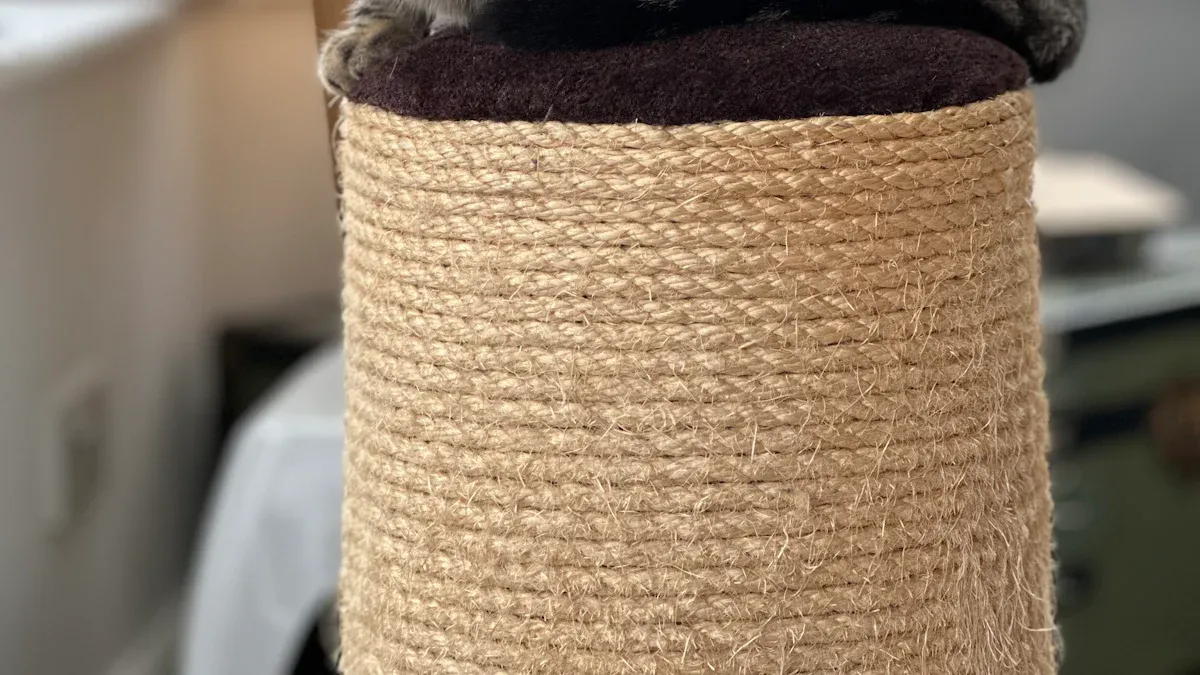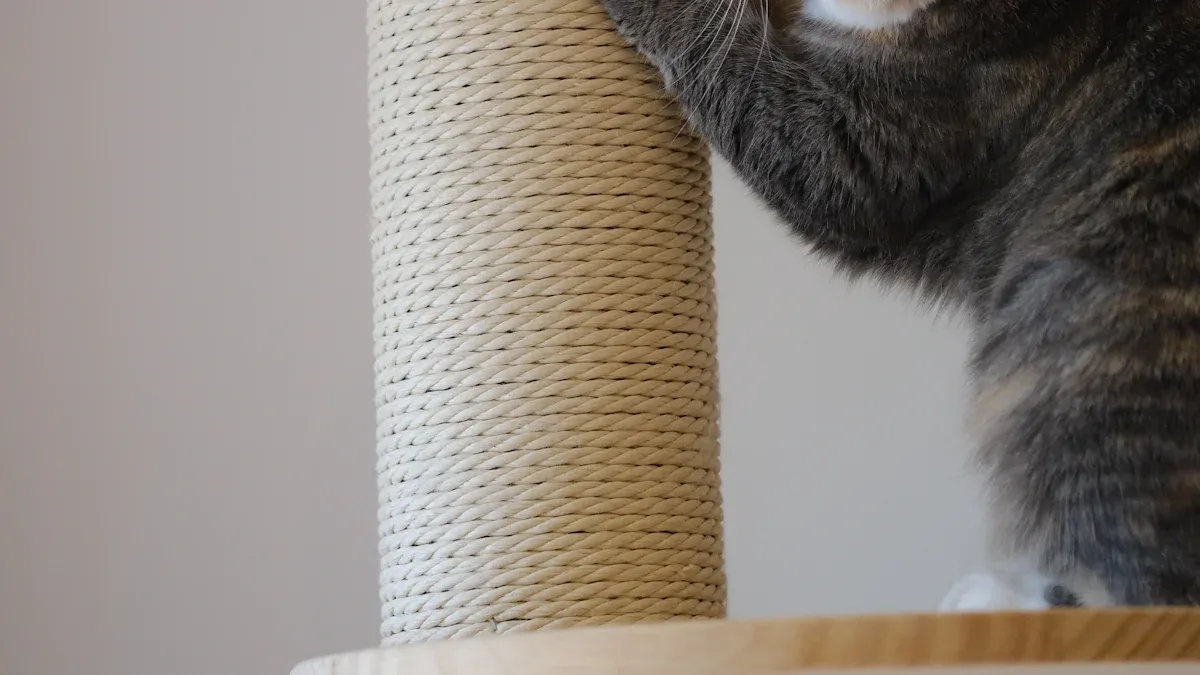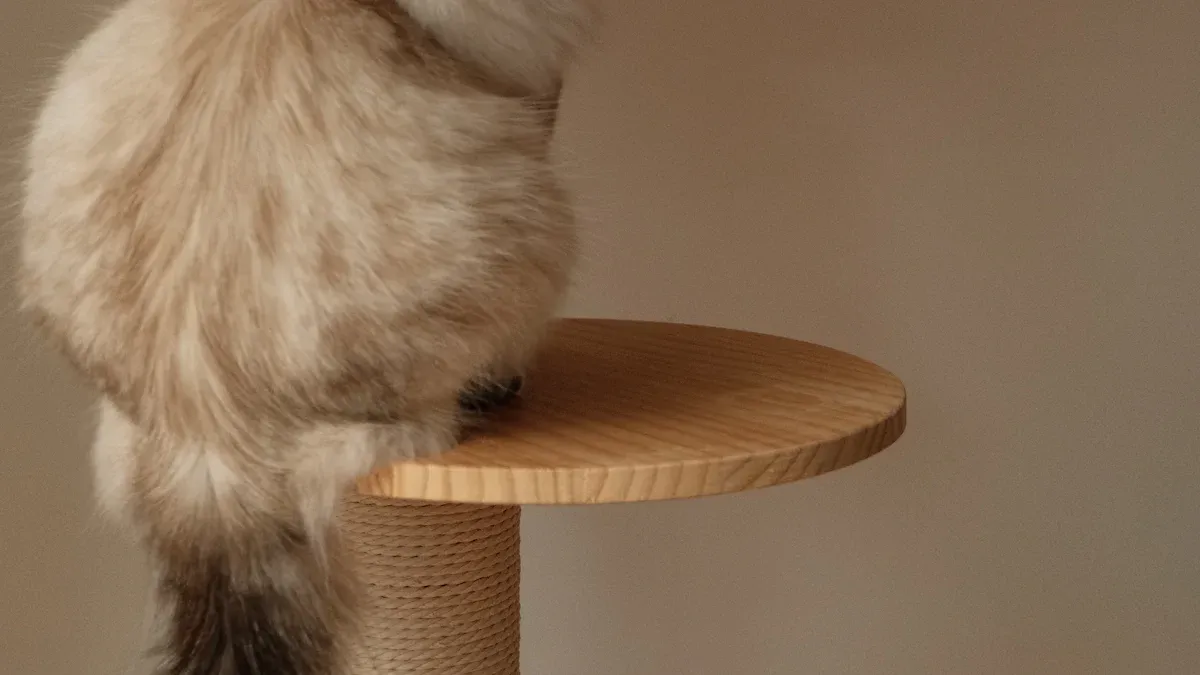How to stop your cat from scratching furniture

Cats love to scratch—it’s an instinctive behavior that helps them stretch, relieve stress, and maintain sharp claws. However, when your furniture becomes their go-to scratching spot, it can quickly become a challenge. If you're wondering how to stop cat from scratching furniture, you're not alone—studies reveal that 57.5% of cat owners experience damage to household items, with over 81% of cats targeting chairs and furniture. The key to preventing this lies in understanding your cat’s natural instincts and providing them with more appealing alternatives.
Key Takeaways
-
Learn why your cat scratches. It helps them stretch, mark spots, and feel calm.
-
Give your cat fun scratching options like posts or pads. Put them close to furniture to stop bad scratching.
-
Praise your cat for good behavior. Give treats or kind words when they use the scratching post.
-
Cut your cat's nails often to protect furniture. Short nails cause less harm when they scratch.
-
Never punish your cat for scratching. Instead, kindly show them where to scratch.
Why Cats Scratch Furniture

Understanding the Natural Instinct
Scratching is not just a random habit. It’s a natural behavior all cats have. From a young age, cats scratch different surfaces using their front paws. But why do they scratch? The reasons are tied to their instincts and needs.
-
Marking Territory: Scratching leaves marks and scents behind. Cats have scent glands in their paws. When they scratch, they’re saying, "This spot is mine." It helps them feel safe and comfortable.
-
Stretching and Exercise: Scratching is like a yoga stretch for cats. It stretches their muscles and keeps them strong and flexible.
-
Claw Maintenance: Scratching removes the old outer layer of claws. This keeps their claws sharp and healthy, like a grooming routine for their paws.
-
Stress Relief: Cats scratch to release stress, just like people fidget when nervous. It helps them relax and feel better.
-
Hunting Instincts: Scratching mimics hunting moves like pouncing and stalking. Even indoor cats still have these natural instincts.
Studies show that a cat’s environment can affect how much they scratch. Busy homes or homes with kids often see more scratching. This might be how cats handle the noise and activity around them.
Tip: If your cat scratches too much, it could mean they’re stressed or marking their space. Watch their actions to understand what they need.
Benefits of Scratching for Cats
Scratching isn’t only about marking spots or keeping claws sharp. It has many other benefits that help your cat stay happy and healthy. Here’s why scratching matters:
|
Benefit |
Description |
|---|---|
|
Physical Health |
Scratching stretches muscles and keeps joints flexible. |
|
Mental Stimulation |
It keeps their mind active and prevents boredom. |
|
Stress Reduction |
Scratching helps cats release energy and feel calm. |
|
Territorial Comfort |
Marking their space makes cats feel safe and secure. |
|
Claw Health |
It removes old claw layers, helping new ones grow. |
Research shows scratching can boost a cat’s mood. Cats often scratch after waking up or during play because it feels good. It’s their way of staying happy and healthy.
Note: Give your cat different scratching options like posts or mats. Cats like tall, sturdy structures, so pick ones that won’t tip over.
How to Stop Cats from Scratching Furniture
Provide Scratching Posts and Pads
To stop cats from scratching furniture, give them better options. Cats like rough surfaces where they can dig their claws. Scratching posts and pads are great choices. Place these near spots your cat already scratches or spends time. For instance, if your cat scratches the sofa arm, put a post nearby. This gives them an easy and fun alternative.
Pick a tall, sturdy scratching post for your cat. Cats like to stretch while scratching, so avoid wobbly posts. Flat pads or mats work well for cats who scratch horizontally. Try materials like sisal, cardboard, or carpet to see what your cat prefers.
Studies show scratching posts reduce unwanted scratching. For example:
|
Study Description |
Results |
|---|---|
|
Study 1: FeliScratch solution applied to scratching surfaces |
|
|
Study 2: FIS analogue vs. placebo |
Significant increase in median duration and frequency of scratching with FIS treatment |
This proves the right tools can help a lot. Reward your cat when they use the post. A little praise or treat can encourage good behavior.
Tip: Sprinkle catnip on the post or pad to make it more fun. Cats love the smell and will enjoy using it.
Use Positive Reinforcement
Cats learn well with positive reinforcement, so use it wisely. When your cat uses their scratching post, praise them happily. You can also give treats or playtime as a reward. This teaches them that scratching the right spot is good.
If your cat scratches furniture, don’t yell or punish them. Instead, gently guide them to the scratching post. For example, pick them up and place them near the post. Encourage them to use it. Over time, they’ll understand where to scratch.
Be consistent. Everyone in your home should follow the same rules. If one person allows scratching on the couch and another doesn’t, your cat will get confused. Stick to positive reinforcement, and you’ll see improvement.
Note: Avoid negative methods like spraying water or shouting. These can stress your cat and make scratching worse.
Trim Your Cat’s Nails
Trimming your cat’s nails can reduce scratching damage. Long nails may cause discomfort, leading to more scratching. Regular trims keep your cat comfortable and protect your furniture.
Here’s why nail trimming helps:
-
Scratching doesn’t control nail length; it’s for marking territory.
-
Long nails can hurt, making cats scratch more often.
-
Trimming nails reduces discomfort and protects your furniture.
Use cat nail clippers and trim just the sharp tips. Don’t cut too close to the quick, the pink part with blood vessels. If unsure, ask your vet or groomer for help.
Pro Tip: Make nail trimming fun by giving treats or cuddles after. This keeps your cat calm and cooperative.
By using scratching posts, positive reinforcement, and nail trimming, you can stop your cat from scratching furniture and keep your home looking nice.
Use Sprays or Sticky Tapes to Stop Scratching
If your cat still scratches furniture, sprays or tapes can help. These tools make furniture less fun for cats by affecting their senses. Cats use touch and smell a lot, so bad smells or sticky feelings can stop scratching.
How Sprays Work
Sprays have smells like citrus or vinegar that cats dislike. When sprayed on furniture, the scent makes cats avoid scratching. Some cats may ignore the smell or get used to it. To keep it working, spray often.
How Sticky Tapes Work
Sticky tape feels unpleasant on a cat’s paws. Cats avoid areas with tape because they don’t like the sticky feeling. Put tape on sofa edges, chairs, or other spots your cat scratches. Over time, cats learn to stay away.
Here’s a quick comparison of sprays and tapes:
|
Deterrent Type |
How It Works |
Pros and Cons |
|---|---|---|
|
Sticky Tape |
Makes paws feel sticky and uncomfortable. |
Works well but may lose stickiness, collect dirt, or harm surfaces. Needs regular replacement. |
|
Smelly Sprays |
Uses scents cats dislike, like citrus or vinegar. |
May not work for all cats and needs frequent spraying. Cats might get used to the smell over time. |
Tips for Using Sprays and Tapes
-
Test First: Try sprays or tape on a hidden spot to avoid damage.
-
Add Scratch Posts: Use deterrents with scratch posts nearby. This gives cats a better place to scratch.
-
Stay Consistent: Apply sprays or tape often. Cats are stubborn, so keep up with them.
Sprays and tapes can protect furniture and teach cats better habits. Pair them with rewards and scratch posts for the best results.
Tools to Stop Your Cats from Scratching Furniture

Self-Adhesive Cat Scratch Pads

Self-adhesive cat scratch pads are super helpful for protecting furniture. These pads stick to surfaces like sofas, walls, or doors. They give your cat a fun place to scratch without causing damage. The rough texture feels just right for cats, making them want to use it.
Using these pads is simple. Just peel off the backing and stick them on. No tools are needed! They come in different sizes and colors to match your home. You can even cut them to fit tricky spots. Place them where your cat scratches most, and they’ll start using the pad instead.
Tip: Put a scratching post near the pad for more options. Reward your cat with treats when they use the pad.
Natural Sisal Cat Scratcher Mats

Natural sisal scratcher mats are another great way to stop furniture scratching. Made from eco-friendly sisal, these mats have a firm texture cats love. Lay them flat, wrap them around furniture legs, or mount them on walls. They’re super flexible and easy to use.
Older cats, especially those over 14, often prefer flat mats. Horizontal mats are gentler on their joints than tall posts. Sisal mats also help with claw care and stress relief, keeping your cat happy.
-
Cats enjoy sisal and carpet textures for scratching.
-
Flat mats are better for older cats with joint issues.
-
Scratching on sisal helps with marking and claw health.
Note: Place mats in busy areas or near your cat’s favorite spots. This makes it more likely they’ll use them.
Cat Scratching Pads and Loungers

Cat scratching pads and loungers are both useful and stylish. They combine a scratching surface with a comfy resting spot. The sisal or cardboard layer satisfies scratching needs, while the sturdy base is perfect for lounging.
Put loungers near windows, sofas, or corners where your cat likes to relax. They’re great for big cats or homes with multiple cats. Loungers offer plenty of space for scratching and resting. Their sleek design fits well with modern furniture, so they look good too.
Pro Tip: Sprinkle some catnip on the lounger to make it extra fun. Your cat will love spending time there.
Modern Cat Scratching Posts

Modern cat scratching posts are a game-changer when it comes to protecting your furniture. These posts don’t just serve as scratching tools—they’re designed to fit seamlessly into your home while keeping your cat happy. If you’re tired of bulky, unattractive scratchers, modern designs offer a stylish solution.
Why Choose Modern Scratching Posts?
Modern scratching posts combine functionality with aesthetics. They’re tall enough for your cat to stretch fully, which is great for their muscles and joints. The sturdy base keeps them stable, even during vigorous scratching sessions. Plus, the natural sisal rope used on these posts mimics the texture cats love, making them irresistible.
You’ll find these posts in sleek, minimalist designs that blend into any room. Whether your home has a contemporary vibe or a cozy feel, there’s a scratching post that matches your style. Some even come with added features like interactive toys or plush perches, giving your cat a space to play and relax.
"I cannot believe how perfect this lounge is for my cat, and the fact that it is beautiful and unobtrusive in my living room is a bonus. It is so much better than any scratch pad I have ever seen in the market, and it is worth every penny."
This feedback highlights how modern scratching posts not only satisfy your cat’s needs but also enhance your living space.
How to Use Them Effectively
Place the scratching post near areas your cat already scratches. Cats often target spots they spend time in, like near the sofa or by a window. Sprinkle a bit of catnip on the post to make it even more appealing. Reward your cat with treats or praise when they use it. Over time, they’ll prefer the post over your furniture.
Modern cat scratching posts are a win-win. They keep your cat entertained and your furniture safe, all while adding a touch of style to your home.
What Not to Do When Trying to Stop Cats from Scratching
Avoid Declawing
Declawing might seem like an easy solution, but it’s harmful. This surgery removes not just the claws, but also part of the toe bone. It’s like cutting off the tips of your fingers. Declawing can cause pain and behavior problems for your cat.
Research shows declawed cats often have health issues. Here are some risks:
|
Outcome |
Odds Ratio (OR) |
Description |
|---|---|---|
|
Back Pain |
2.9 |
Cats walk differently after declawing, which can hurt their spine. |
|
Periuria/Perichezia |
7.2 |
Higher chance of accidents, like peeing outside the litter box. |
|
Biting |
4.5 |
Declawed cats may bite more because they feel defenseless. |
|
Aggression |
8.9 |
More likely to act aggressively, especially if claw fragments remain. |

Declawing doesn’t fix why cats scratch. Instead, it can make them stressed and unhappy. Better options include trimming nails or giving scratching posts.
Tip: Ask your vet for advice on safe ways to stop scratching.
Don’t Punish Your Cat
Punishing your cat for scratching furniture doesn’t work. Cats don’t understand yelling or being sprayed with water. These actions can make them scared or stressed. Stress might even make them scratch more.
Instead, guide your cat to a scratching post when they scratch furniture. Praise them when they use it. Rewards like treats or playtime help teach good habits.
Note: Cats scratch because it’s natural, not to be bad. Be patient and kind when solving the problem.
Avoid Ignoring the Behavior
Ignoring scratching won’t stop it. Cats scratch to stretch, mark their space, and care for their claws. Without alternatives, they’ll keep scratching furniture. Offer scratching posts or mats to meet their needs.
Studies show humane solutions work best for managing scratching. Declawing is harmful, but understanding your cat’s instincts helps. Giving them proper outlets keeps your furniture safe and your cat happy.
Pro Tip: Place scratching posts where your cat spends time. This makes it easier for them to use the right spot.
Ignoring scratching can frustrate both you and your cat. Take steps to guide their behavior positively.
Stopping your cat from scratching furniture needs time and care. Understand their instincts and give them better options. Use scratching posts, sprays, or covers to protect furniture. Many owners succeed by adding several scratching posts at home. Some avoid scratching problems by setting up before getting a cat.
🐾 Research shows tools like the Feliway® Classic Diffuser can help. But not every method works for all cats. Be consistent. Praise your cat for using the right spots and stay patient. With time, your cat will scratch less and feel happier.
FAQ
How do I know which scratching post my cat will like?
Cats have preferences for textures and orientations. Start with a sisal-covered post and a flat mat. Place them near your cat’s favorite spots. Observe which one they use more. If they ignore both, try sprinkling catnip or using a different material like cardboard.
Can I train my cat to stop scratching furniture completely?
You can’t stop scratching entirely—it’s natural for cats. Instead, redirect their behavior to scratching posts or pads. Use positive reinforcement when they scratch the right spot. Over time, they’ll prefer the alternatives you provide.
How often should I trim my cat’s nails?
Trim your cat’s nails every 2–4 weeks. Regular trims prevent overgrowth and reduce damage to furniture. If your cat resists, trim just one or two nails at a time. Reward them with treats to make the experience positive.
What if my cat ignores the scratching post?
Try moving the post to a more accessible location. Cats often scratch where they spend time. Sprinkle catnip on the post or use a toy to encourage interaction. Experiment with different textures or heights to find what your cat prefers.
Are there any safe sprays to deter cats from furniture?
Yes, sprays with citrus or herbal scents work well. Cats dislike these smells, so they avoid sprayed areas. Test the spray on a small spot first to ensure it doesn’t damage your furniture. Pair sprays with scratching posts for the best results.
See Also
Prevent Cats from Damaging Furniture with a Scratch Pad
Best Cat Scratching Posts of 2025 for Happy Cats
Gabby Whale's Wooden Scratching Post: A Furniture Protector
Training Your Cat to Use a Scratching Post Effectively
Essential Reasons to Choose Gabby Whale's Cat Scratching Post








